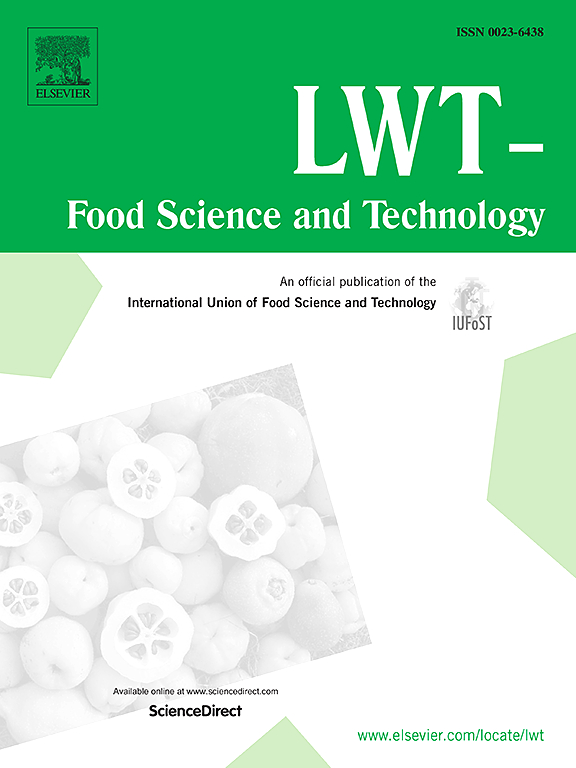焙烧对紫玉米粉品质的影响及环糊精添加花青素及其化合物对紫玉米粉固体饮料品质的影响
IF 6
1区 农林科学
Q1 FOOD SCIENCE & TECHNOLOGY
引用次数: 0
摘要
紫玉米粉在食品工业中有着广泛的应用。然而,不合适的烹饪条件和花青素含量导致PCF和相应的PCF固体饮料的香气、颜色、味道和功能不利。为了解决这些质量问题,作者研究了焙烧对PCF质量的影响,以及添加紫玉米芯花青素(PCCA)对PCF固体饮料质量的影响,重点研究了焙烧对花青素含量和香气的影响,以及微胶囊化对涩味和功效的影响。PCF在175°C下烘烤4 min,香气最浓郁、最均衡,花青素保留率高,感官评分高。焙烧后,鉴定出49种代谢物,其中上调13种,下调36种。烘焙降低了醚、有机酸、烯烃、烷烃、酯和醛的含量,同时增加了芳香烃、杂环化合物和酮的含量,从而产生了烘烤后的奶酪味、甜味和咖啡味。将PCCA包被β-CD作为壁材(壁芯比为2:1)制备微胶囊,有效地消除了固体饮料的涩味,降低了固体饮料的酸味。当微胶囊含量为10%时,其疗效与未包封的PCCA含量为2%时无显著差异。由于氢键作用,β-CD和PCCA形成的微胶囊呈不规则块状结构。研究结果为食品加工业对PCCA的利用和基于pcf的产品的开发提供了有价值的见解。本文章由计算机程序翻译,如有差异,请以英文原文为准。
Effects of roasting on purple corn flour quality and addition of anthocyanins and their compounds with cyclodextrin on purple corn flour solid drink quality
Purple corn flour (PCF) has broad applications in the food industry. However, unsuitable cooking conditions and anthocyanin contents lead to unfavorable aroma, color, taste, and functionality of PCF and in the corresponding PCF solid drinks. To address such quality issues, the authors examined the effects of roasting on PCF quality and adding purple corncob anthocyanins (PCCA) on PCF solid drink quality, with a focus on how roasting influences anthocyanin content and aroma, and how microencapsulation influences astringency and efficacy. PCF roasted at 175 °C for 4 min had the most intense and well-balanced aroma, a high anthocyanin retention rate, and a high sensory score. After roasting, 49 metabolites were identified, including 13 upregulated and 36 downregulated compounds. Roasting reduced the levels of ethers, organic acids, olefins, alkanes, esters, and aldehydes, while increasing aromatic hydrocarbons, heterocyclic compounds, and ketones, contributing to roasted, cheesy, sweet, and coffee-like aromas. Microcapsules prepared by embedding PCCA in β-CD as the wall material (wall-core ratio: 2:1) effectively eliminated the astringency and reduced the sour taste of the solid beverage. Compared with that of unencapsulated PCCA at 2 %, no significant difference was noted in efficacy when the microcapsule content was 10 %. The microcapsules formed by β-CD and PCCA exhibited an irregular blocky structure owing to hydrogen bonding. The findings offer valuable insights into PCCA utilization in the food processing industry and development of PCF-based products.
求助全文
通过发布文献求助,成功后即可免费获取论文全文。
去求助
来源期刊

LWT - Food Science and Technology
工程技术-食品科技
CiteScore
11.80
自引率
6.70%
发文量
1724
审稿时长
65 days
期刊介绍:
LWT - Food Science and Technology is an international journal that publishes innovative papers in the fields of food chemistry, biochemistry, microbiology, technology and nutrition. The work described should be innovative either in the approach or in the methods used. The significance of the results either for the science community or for the food industry must also be specified. Contributions written in English are welcomed in the form of review articles, short reviews, research papers, and research notes. Papers featuring animal trials and cell cultures are outside the scope of the journal and will not be considered for publication.
 求助内容:
求助内容: 应助结果提醒方式:
应助结果提醒方式:


